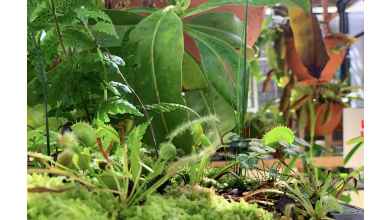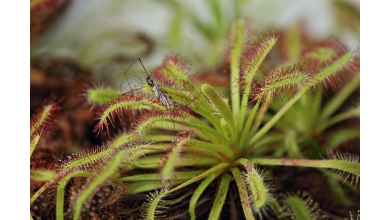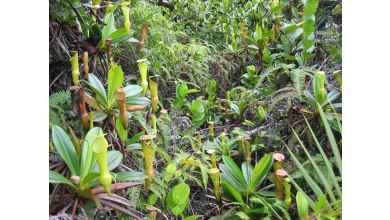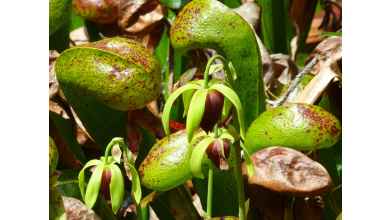Carnivorous Plant Help & FAQs
Carnivorous plants are unique and fascinating. They have adapted to survive in low-nutrient environments by developing the ability to trap and digest insects and other small prey. If you are new to growing carnivorous plants, you may have some questions. This article will provide you with helpful information and answers to some of the most frequently asked questions about carnivorous plants.
IntroductionWhy grow carnivorous plants?
Types of carnivorous plants
- Venus Flytrap
- Pitcher Plants
- Sundews
- Bladderworts
- Butterworts
- Soil
- Water
- Light
- Temperature
- Humidity
- Feeding
Carnivorous plant FAQs
- How often should I water my carnivorous plant?
- Can I fertilise my carnivorous plant?
- Can I keep my carnivorous plant indoors?
- How do I winterize my carnivorous plant?
- Can I divide my carnivorous plant?
Why grow carnivorous plants?
Carnivorous plants are not only fascinating, but they also serve as effective natural pest control. They are low-maintenance plants that can add a unique touch to your garden or home. Growing carnivorous plants can also be an enjoyable hobby and a great way to learn about the natural world.
Types of carnivorous plants
There are several types of carnivorous plants, each with its unique characteristics and growing requirements. Here are some of the most popular types:
Venus Flytrap
The Venus Flytrap is one of the most well-known carnivorous plants. It is native to the wetlands of North and South Carolina and is known for its trap-like leaves that snap shut when an insect lands on them. Venus Flytraps require lots of light and moist, well-draining soil.
Pitcher Plants
Pitcher Plants are another popular type of carnivorous plant. They have tube-shaped leaves that trap insects and other small prey. Pitcher Plants come in many different shapes and sizes and can be found in various parts of the world. They thrive in high humidity and moist soil.
Sundews
Bladderworts are aquatic carnivorous plants that trap prey in bladder-like structures on their leaves. There are over 220 species of Bladderworts, and they can be found in a variety of aquatic habitats worldwide. Bladderworts require full sun and acidic water.
Bladderworts
Bladderworts are aquatic carnivorous plants that trap prey in bladder-like structures on their leaves. There are over 220 species of Bladderworts, and they can be found in a variety of aquatic habitats worldwide. Bladderworts require full sun and acidic water.
Butterworts
Butterworts are small carnivorous plants that catch insects with sticky, glandular leaves. There are over 80 species of Butterworts, and they can be found in various parts of the world. They require bright, indirect light and well-draining soil.
Growing carnivorous plants
Growing carnivorous plants can be easy if you understand their specific requirements. Here are some tips for growing healthy carnivorous plants:
Soil
Carnivorous plants require soil that is low in nutrients and has good drainage. You can purchase soil specifically designed for carnivorous plants or make your own using peat moss, sand, and perlite.
Water
Carnivorous plants require distilled or rainwater because tap water contains minerals that can harm them. Make sure to keep the soil moist but not waterlogged.
Light
Carnivorous plants require lots of bright light to thrive. Different types of carnivorous plants have different light requirements, but most prefer bright, indirect sunlight.
Temperature
Carnivorous plants prefer moderate temperatures between 15-27°C. They can tolerate lower temperatures but may not grow as quickly.
Humidity
Carnivorous plants thrive in high humidity. You can increase humidity levels by placing a tray of water near your plants or using a humidifier.
Feeding
Carnivorous plants obtain most of their nutrients from insects and other small prey. You can feed them by placing insects on their leaves or using insect frass or fish food as fertiliser
Common problems and solutions
Here are some common problems that carnivorous plant growers may encounter and how to solve them:
Brown spots on leaves
Brown spots on carnivorous plant leaves can indicate too much direct sunlight or over-fertilization. Move your plant to a shadier location and avoid using fertiliser.
Mould
Mould can grow on the soil or leaves of carnivorous plants if they are too wet. Increase ventilation or move your plant to a drier location to prevent mould growth.
Pests
Carnivorous plants can still be affected by pests such as spider mites or aphids. Use an insecticidal soap or neem oil to control pest populations.
Carnivorous plant FAQs
- How often should I water my carnivorous plant?
- Carnivorous plants should be kept moist but not waterlogged. Water them when the top inch of soil is dry.
- Can I fertilise my carnivorous plant?
- Carnivorous plants obtain most of their nutrients from insects and other small prey. You can use insect frass or fish food as fertiliser sparingly, but avoid using traditional fertilisers as they can harm the plants.
- Can I keep my carnivorous plant indoors?
- Yes, most carnivorous plants can be grown indoors as long as they have access to bright, indirect sunlight and appropriate soil and water conditions.
- How do I winterize my carnivorous plant?
- Carnivorous plants that are grown outdoors may need to be brought indoors during the winter months or covered with a frost cloth. Indoor plants may need to be moved to a cooler location or have their watering frequency decreased.
- Can I divide my carnivorous plant?
- Yes, some carnivorous plants can be divided to create new plants. Research specific species for best practices on dividing and propagating.
Conclusion
Carnivorous plants are fascinating and unique plants that can add a touch of intrigue to your home or garden. By understanding their specific requirements, you can grow healthy and thriving plants that serve as natural pest control. Remember to use distilled or rainwater, avoid over-fertilization, and provide bright, indirect sunlight and high humidity. Happy growing!






